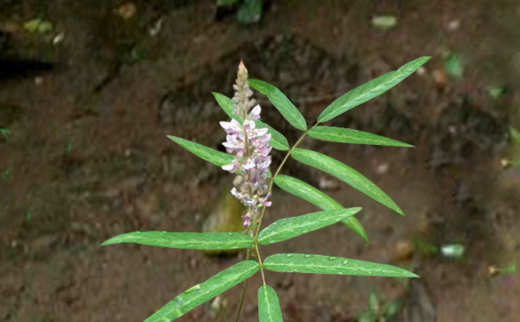Prishnaparni / Uraria Picta – Ayurvedic Properties, Benefits, Uses, Part Used & More
Abstract
Prishniparni (Uraria picta Desv.) is regarded as one of the most significant herbs in Ayurveda. It is a key component of Dashamoola, a classical group of ten roots widely used for treating various Vata-related disorders. Dashamoola is divided into two subgroups: the Brihat Panchamoola, consisting of five large tree species (Bilva, Agnimantha, Kashmari, Shyonaka and Patala), and the Laghu Panchamoola, comprising five smaller shrubs (Brihati, Kantakari, Shalaparni, Prishniparni and Gokhru).
Uraria picta typically grows in dry grasslands, open forests, and wastelands. It is commonly found throughout the plains of India and along the sub-Himalayan region, from Kashmir to West Bengal and Assam, up to an altitude of 1800 meters.

Introduction
Uraria picta [syn. Doodia picta Roxb., Hedysarum pictum Jacq.] is commonly known as “wizardry” or “sleight of hand.” In Ayurveda, it is referred to as Prishniparni or Pithvan, and it belongs to the Papilionaceae family, under the subfamily Fabaceae. Locally, it is also called “Dabra.”
The name Prishniparni is derived from two Sanskrit words: Parsni, meaning “small,” and Parni, meaning “leaf.” In English, it is often referred to as “The pointed-leaved uraria plant.” This plant has been described in numerous classical Ayurvedic texts and holds a sacred role in the rejuvenation and balancing of tridoshas (Vata, Pitta and Kapha). Its therapeutic usage includes the management of fever, respiratory disorders, arthritis, and general weakness. With scientific validation of its traditional uses, Uraria picta is now being recognised for its broad-spectrum health benefits.
Scientific Classification
- Kingdom – Plantae
- Subkingdom – Tracheobionta
- Division – Magnoliophyta
- Class – Magnoliopsida
- Order – Fabales
- Family – Fabaceae
- Genus – Uraria
- Species – Uraria picta
Synonyms
- Prishniparni – Named for its slender, elongated leaves
- Prithakparni – Noted for its distinctly different leaf structure compared to other plants
- Kalashi – Known to enhance and nourish the Shukra Dhatu (reproductive tissue)
- Dhavani – Recognised for its detoxifying properties, helping eliminate toxins from the body
- Kostruka Puchika – Its flower clusters resemble the tail of a jackal
- Simhapuchi – Its inflorescence resembles the tail of a lion
- Guha – The plant is characterised by roots that penetrate deep into the earth
- Shrugalavinna, Chitraparni – Traditional synonyms denoting its distinct and colourful foliage
- Anghriparni – Named for its densely packed leaves along the stem
Vernacular Names
- Hindi – Pithavan, Dabra
- English – Prishniparni
- Marathi – Pithvan, Prushnipamee
- Gujarati – Pithavan
- Tamil – Oripai, Sittirappaladi
- Telugu – Kolakuponna, Muyyakupona
- Punjabi – Detedarnee
- Kannada – Murelehone, Ondelehonne, Prushniparni
- Bengali – Salpani, Chhalani, Chakule
- Malayalam – Orila
Habitat
Uraria picta is commonly found in dry grasslands, open areas with scattered trees such as Acacia, rocky terrains and deep sandy soils. It also grows in wastelands, along riverbanks, floodplains and within gallery forests. This species is widely distributed across tropical regions of Africa, South and Southeast Asia, as well as Australia.
Morphology
The leaves of Uraria picta are typically composed of three to five and occasionally up to nine, arranged in an imparipinnate fashion. The leaflets are linear-oblong, obtuse at the tip and end in a small mucro. Their upper surface displays a characteristic whitish, clouded appearance, while the underside is covered with fine hairs, giving it a pubescent texture. The plant bears purplish flowers, each measuring around 6–10 mm, which appear on dense, cylindrical racemes that can reach up to 20 cm in length. These racemes are adorned with caduceus bracts about 1.5 cm long, which obscure the flower buds. The inflorescence consists of a rachis measuring 8–12 cm. The calyx is 4–6 mm long, hairy, and features teeth that are significantly longer than the tube. The corolla is purplish to bluish and prominently exerted. Flowering and fruiting occur from August to October. The plant produces 1 to 12 reniform (kidney-shaped), reddish seeds.
Varieties
There is a difference of opinion among the Vaidyas about Shalparni and Prishniparni. Vaidyas of some places consider that Shalparni, which is written as Prishniparni and they consider this Shalparni as Prishniparni. The word Kroshtuvitra has been used as a synonym of Prishniparni which can be suitable only for the trees having a tail-shaped panicle of the Uraria species. From this point of view, it seems appropriate to consider Uraia picta Desv. as Prishniparni. Uraria lagopoides DC. can be considered as Shalparni because its leaves are like Shal leaves. Some people consider Shaliparni as a tree having leaves like Shalidhanya tree. Similarly, on the basis of its synonyms given in various Nighantu, people try to prove various Kshupas as Shalparni or Prishniparni.
Its another species is Uraria hamosa Wall. In which the clusters are long but not dense, and the leaves are leafless or trifoliate. It is called Salpani (Shalparni) in Orissa. Actually, the name ‘Salpani’ is given to many species of plants.
Classical Categorisation
According to Charaka Samhita
- Angamardhaprashamana – Category of herbs beneficial in relieving body aches and muscular pain
- Shothahara – Group known for its anti-inflammatory action
- Sandhaneeya – Herbs traditionally used to support the healing of fractures and joint dislocations
According to Sushruta Samhita
- Listed under Vidarigandhadi Gana and the Haridradi group of herbs
According to Ashtanga Hridaya (Vagbhata)
- Included in the Haridradi Gana
According to Bhavaprakasha Nighantu
- Classified under Guduchyadi Varga
Ancient Verses
पृश्निपर्णी त्रिदोषघ्नी वृष्योष्णा मधुराऽसरा ।
हन्ति दाहज्वरश्वासरक्तातीसारत्वमीः ॥
(Bhavprakash Nighantu Guduchyadi Varga 274)
According to the above shloka, Prihnaparni has hot potency and sweet taste. It helps to balance all three doshas and contains absorbent and aphrodisiac properties. It is effective in the management of burning sensation, fever, asthma, excess thirst, vomiting and bleeding stools.
Ayurvedic Properties
- Taste (Rasa)- Bitter (Tikta), Sweet (Madhur)
- Physical property (Guna) – Light (Laghu), Unctuous (Snigdha)
- Potency (Veerya )- Hot Potency (Usna)
- Post-digestion effect (Vipaka)- Sweet (Madhur)
- Effect on tridosha– Balance Vata, Pitta and Kapha dosha
Therapeutic Properties
- Aphrodisiac
- Antiseptic
- Antimalarial
- Abortifacient
- Skin-protective
- Cardioprotective
- Antihypertensive
- Antitachycardic
- Antianginal
- Antigonorrheal
- Antityphoid
- Antitetanus
- Antidote
- Neuroprotective
- Expectorant
- Antipyretic
- Anti-inflammatory
- Antigout
- Antiobesity
- Dermatological
- Nephroprotective
- Antialzheimer’s
Systemic Actions
- Nervous System – Supports and strengthens the nervous system and helps in balancing Vata dosha.
- Digestive System – Acts as a carminative and absorbent and promotes proper movement of doshas. Beneficial in conditions like bloody diarrhoea, bleeding piles, malabsorption and excessive thirst.
- Circulatory System – Useful in managing oedema, gout and blood-related disorders and functions as a heart tonic.
- Respiratory System – Aids in eliminating aggravated Kapha dosha and is helpful in cough, asthma, and other respiratory conditions.
- Reproductive System – Works as an aphrodisiac and is indicated in low sperm count (oligospermia).
- Excretory System – Promotes urination and is useful in cases of painful or difficult urination (dysuria).
- Satmikarana (Rejuvenation) – Possesses anti-toxic properties and assists in bone healing, enhances vitality, and is useful in general debility.
- Tapakrama (Fever Management) – Reduces fever and is especially effective in fevers accompanied by a burning sensation.
Chemical Composition
- Phenolics
- Tannins
- Saponins
- Cardiac glycosides
- Flavonoids
- Isoflavanones (e.g., 5,7-dihydroxy-20-methoxy-30,40-methylenedioxyisoflavanone; 40,5-dihydroxy-20,30-dimethoxy-7-(5-hydroxyoxychromen-7yl)-isoflavanone)
- Triterpenes
- Steroids (including stigmasta-4,22-diene-3-one, β-sitosterol, lupeol)
- Flavone glycoside (Rhoifolin) from aerial parts
- Canavanine (from seeds)
- Essential and non-essential amino acids (from seeds)
- Albumin-like proteins (from seeds)
- Linoleic acid (38.9%)
- Palmitic acid (14.2%)
- Linolenic acid (11.3%)
- Oleic acid (11.1%)
- Sodium (Na)
- Potassium (K)
- Calcium (Ca)
- Magnesium (Mg)
- Phosphorus (P)
Modern Overview
Antidiarrheal activities
The antidiarrheal activity of Uraria picta is primarily attributed to its isoflavanone, such as 5,7-dihydroxy-2′-methoxy-3′,4′-methylenedioxyisoflavanone and 4′,5-dihydroxy-2′,3′-dimethoxy-7-(5-hydroxyoxychromen-7yl)-isoflavanone and other bioactive phytochemicals such as flavonoids and tannins, which work through multiple mechanisms to control diarrhea…
Antipyretic Activity
Uraria picta is rich in flavonoids and phenolic compounds that contribute to its traditional use as an antipyretic and anti-inflammatory herb. These bioactive compounds help modulate the immune response by reducing the production of pro-inflammatory cytokines such as IL-1β, IL-6 and TNF-α, which are pivotal in the onset and regulation of fever. By inhibiting these cytokines, the plant helps suppress the inflammatory signals that act on the hypothalamus to raise body temperature. Additionally, its antioxidant properties help counteract oxidative stress associated with fever and inflammation. The combination of these actions provides a scientific basis for the traditional use of Uraria picta in treating fevers and inflammatory conditions in Ayurvedic and folk medicine.
Practical Uses
- For Cold and Cough: A decoction made from the roots and leaves is given in a dose of 50 ml twice daily.
- For Joint Pain and Inflammation: Paste of the root is applied over the inflamed joints to reduce swelling.
- For General Debility: Powder of the dried root is taken with warm milk daily for rejuvenation.
- For Asthma: Root decoction with honey helps in easing breathlessness and chest tightness.
- For Digestive Complaints: Root powder is mixed with ginger and taken to relieve bloating and indigestion.
Part Used
- Roots
Dosage
- Powder- 5-10 gm
- Decoction- 50-100ml
Ayurvedic Medicines
Planet Ayurveda Medicines
- Vata Balance
- Amritarisht
- Dashmularisht
- Dashmoola capsules
- Femo Plan Syrup
- Vikramprash
- Kalyanaka Ghrit
Conclusion
Uraria picta, a treasured herb in classical Ayurveda, offers an array of health benefits due to its rich phytochemistry and potent therapeutic actions. Its presence in Dashamoola highlights its importance in treating Vata disorders and inflammatory conditions. With increasing scientific validation, Uraria picta stands as a promising herbal remedy for a wide range of ailments, promoting holistic healing and balance in the body. Proper usage under Ayurvedic guidance can offer natural and sustainable wellness.



